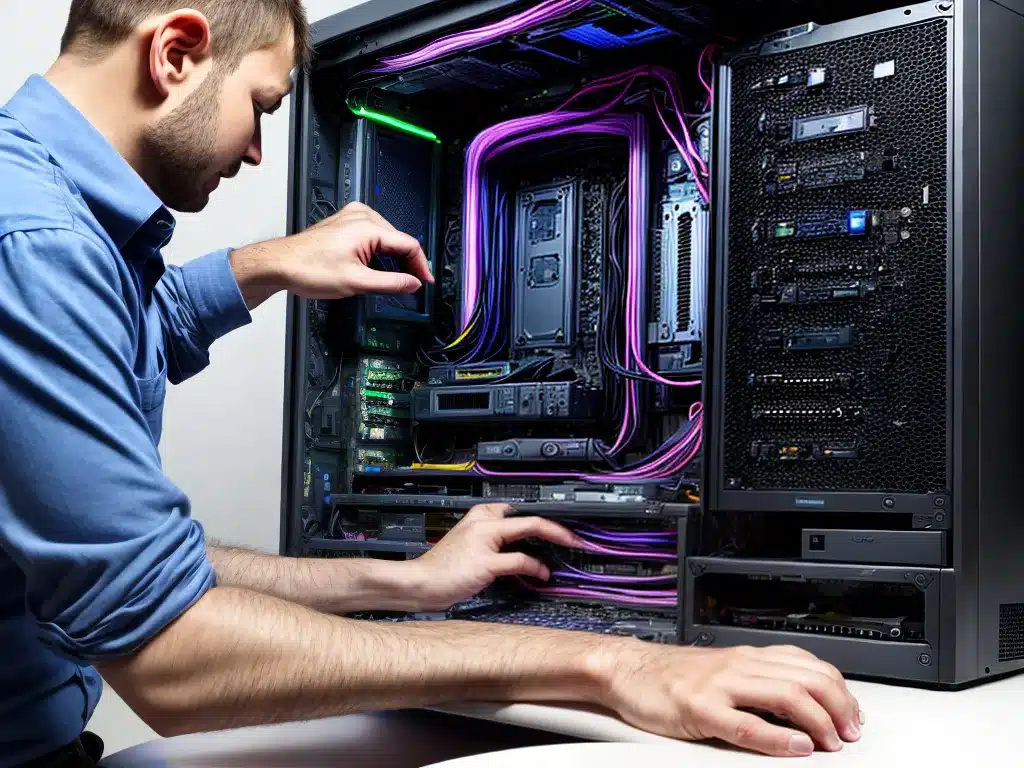
Having computer boot problems can be incredibly frustrating. However, with some troubleshooting and patience, these issues can often be resolved. Here are some tips for fixing common computer boot problems.
Diagnosing the Issue
The first step is to diagnose exactly what is causing your computer to fail to boot properly.
Computer Won’t Turn On
If your computer won’t turn on at all when you press the power button, the issue could be:
-
Faulty power supply – The power supply inside your computer may have failed. Try replacing it with a new one.
-
Loose cable connections – Make sure all power and data cables inside your computer are plugged in properly. Reseat cables to ensure a tight connection.
-
Faulty power button – The power button itself may have stopped working. Try shorting the power switch pins on the motherboard with a screwdriver to rule this out.
Computer Turns On But No Display
If your computer turns on but nothing displays on your monitor, the problem may be:
-
Loose video cable – Double check that the video cable connecting your monitor to your computer is plugged in correctly on both ends.
-
Dead GPU – Your graphics processing unit (GPU) may have died. Try removing the GPU and using integrated graphics instead.
-
Faulty monitor – Try connecting your computer to a different monitor or TV. If you get a display, your original monitor is likely defective.
Computer Boots to Black Screen
A black screen on boot often indicates an issue loading the operating system. Potential causes include:
-
Corrupted system files – Use the original OS install media to run a startup repair or reinstall the OS.
-
Failed hard drive – If your hard drive has mechanical damage or corruption, your computer cannot access the OS. Replace the hard drive.
-
Disconnected hard drive – Open your computer case and make sure the hard drive cables are properly connected.
Troubleshooting Steps
Next, try these general troubleshooting steps:
Check Connections and Reseat Components
-
Carefully check all connections inside your PC. Unplug then firmly reattach power cables, SATA data cables, and other connectors.
-
Remove and reinsert RAM modules and other components to reseat them. This can fix issues from loose or oxidized contacts.
Reset BIOS Settings
- Reset your motherboard BIOS settings to default to undo any settings changes that may be preventing boot. Refer to your motherboard manual for the proper procedure.
Boot to Safe Mode
- If you can access advanced startup options, boot your computer into Safe Mode. This will load Windows with default settings and may resolve software-related boot problems.
Remove Peripherals and Non-Essential Components
- Remove all external devices such as printers, scanners, and USB drives. Also remove any recently added internal components, aside from the essential CPU, RAM, and boot drive.
Check Your Boot Order in BIOS
- Access your BIOS settings and confirm your computer’s boot order is correct. Make sure it tries to boot from your main hard drive before other devices.
Common Boot Problems and Solutions
Here are some solutions to specific boot problems you may encounter:
“No bootable device found”
-
Your BIOS cannot find a bootable disk. Check your boot order settings and make sure your primary hard drive is listed first.
-
If you recently changed boot drives, you may need to select the new one in BIOS.
“BOOTMGR missing”
- Indicates a problem with the Windows bootloader. Startup repair should replace the missing boot files. A reinstall may be required if startup repair fails.
PC constantly reboots while booting
- Can indicate faulty or incompatible RAM. Test each RAM stick individually to isolate the bad one.
Computer boots to a blue or black screen
- Could be an issue with your Windows installation. Startup repair or a clean reinstall of your OS can resolve this.
Computer boots but freezes on the splash screen
- May be caused by a driver conflict or faulty hardware component. Use Safe Mode to find the problem device.
With patience and persistence, you can troubleshoot most computer boot problems. Don’t hesitate to take your PC to a repair shop if you exhaust all self-fix options.












